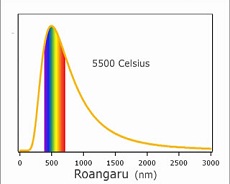Hot Star Cool Star | Tīrama, Tīrama Ngā Whetū
Introduction
Abstract
Blackbody radiation is explored using a halogen light bulb with a dimmer. The results are used to discuss hot and cool stars.
Principles Illustrated
As an object gets hotter it glows more brightly, and the highest intensity radiation is at a shorter wavelength.
Content
Video
English version
Te Reo Māori Version
Instructions
The diffraction grating glasses are used to see the spectrum of light produced by the hot filament, or at least the visible part that gets through the glass of the bulb. As the filament warms, the brightness of all the visible colours increases but the intensity of the blue increases relative to the red. So while an object glowing with a reddish colour is hot, an object glowing with a bluish colour is even hotter. Bluish stars are hotter than reddish stars.
Inexpensive diffraction grating glasses are often available from us or from our source: Rainbow Symphony.
As our “sun” we used a 60 W Osram Halolux 84472 Halogen bulb in some of our experiments, but we have also used an ordinary incandescent bulb with clear glass. One advantage of the Osram bulb is that the filament is oriented vertically, as are the diffraction gratings.



Other Information
Safety
There are the usual electrical safety issues, and also the bulb can get very hot.
Individual teachers are responsible for safety in their own classes. Even familiar demonstrations should be practised and safety-checked by individual teachers before they are used in a classroom.
Related Resources
See also Star Scene Investigation
This demonstration can be expanded by viewing infrared light from a remote control using a webcam, or a heater using a modified webcam. Click here for more information.
Credits
This teaching resource was developed by the Te Reo Māori Physics Project with support from
- Te Puni Kōkiri
- The MacDiarmid Institute
- Faculty of Science, Victoria University of Wellington
- School of Chemical and Physical Sciences, Victoria University of Wellington
- The New Zealand map shown on the poster frame above is used with permission from www.nz.com.
- We are grateful to Dr. Robert Jacobs, Associate Professor of Optometry at The Department of Optometry and Vision Science at Auckland University, for a number of useful conversations and suggestions.
- The astronomical photos are from www.starrynightphotos.com.
- This resource was filmed partly at Te Herenga Waka Marae.
- The electromagnetic spectrum image was adapted from one provided by The Science Learning Hub.
- The human eye cone response graphic was adapted from one provided by Hyperphysics.